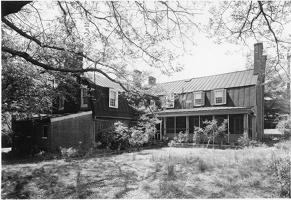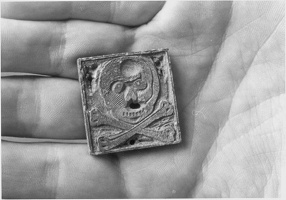THE GREEN PRINT SHOP

Who would have thought that something as small as printer's type could change history? And who would have thought that the discovery of printer's type in Annapolis would lead to recognizing the important place of women in Annapolis, Maryland's past? Scholars have noted for years that women are an all-too-often underrepresented presence in historical accounts or that, when present, they frequently form the background as opposed to the foreground of the events that are recounted.
Over the course of four field seasons spanning 1983-1986, Archaeology in Annapolis conducted excavations at the 18th-century Green Print Shop. What was found archaeologically would lead to interpreting the story of one woman's challenge to society.
Discovering Colonial Lives
Jonas and Anne Catharine Green moved to their Annapolis home on Charles Street from Philadelphia, Pennsylvania in 1738. Jonas Green was no stranger to the business of running a printing press, because his family had been printers for three generations. By 1745, they had begun to print Annapolis' colonial newspaper, the Maryland Gazette. Their print shop, located in a detached building behind their house, would soon play a significant local role in the events that culminated with the American Revolution. Jonas Green was part of a burgeoning industrial class that professed a strict separation of home life from work-not that this was an altogether easy task to accomplish with the Green household consisting of Jonas, Anne Catharine, five surviving children of the 14 they had together, as well as several indentured servants, apprentices, and slaves.

Amid the thousands of pieces of lead printer's type recovered during excavations at the Green Print Shop, one find is worth specific discussion given its association with the broader implications of the Stamp Act. Created by Jonas Green as a means of protesting the British-imposed Stamp Act of 1765, the Death's Head type pictured here is very much like an actual font that appeared in copies of the Maryland Gazette that survives in microfilm and originals at various archives. In addition to incorporating the Death's Head imagery in the paper's printed protests against the various "Intolerable Acts" being levied against colonists, Jonas Green authored several pieces attacking other components of Britains colonial policy in North America.
Ann Catherine Green
After Jonas' death in 1767, his widow Anne Catharine Green assumed the day-to-day operations of the Maryland Gazette and became the paper's official editor. Aside from taking control of the printshop, Anne Catharine made a number of other changes that appear no less "revolutionary" than Jonas' public protest of the Stamp Act.In a review of Anne Catharine Green's 1775 probate inventory, archaeologist Barbara Little noticed that a number of items that had formerly been in the print shop were now listed as being in her house. It appears that Anne Catharine Green rearranged a series of print shop work supplies, and brought an eight day clock, paper, varying tools and a book binding press into the house itself. Seemingly an innocuous discovery, this find affords us the ability to gain insight into Anne Catharine Green's worldview, seen through her relation to work discipline. The change in work routines that resulted from Anne Catharine Green's mixing of work and home life, created an environment of domestic craft production, contradictory to the type of home and work life that Jonas had created.
Further Reading
Galke, Laura June
1995 Societal Change on a Household Level: A Quantitative Spatial Analysis of the Green Family
Print Shop Site. In Annapolis Pasts: Historical Archaeology in Annapolis Maryland, edited by Paul A.
Shackel, Paul R. Mullins and Mark S. Warner, pp.169-189. University of Tennessee Press, Knoxville.
Little, Barbara J.
1987 “Ideology and Media: Historical Archaeology of Printing in 18th-century Annapolis, MD.”Ph. D.
dissertation, State University of New York at Buffalo. Ann Arbor: University Microfilms
International.
1987 Craft and Culture Change in Eighteen-Century Chesapeake. In Recovery of Meaning: Historical Archaeology in the Eastern United States, edited by Mark P. Leone and Parker B. Potter, Jr., pp. 263-292. Smithsonian Institution Press, Washington D.C.
1992 Explicit and Implicit Meanings in Material Culture and Print Culture. Historical Archaeology 26:3:85-94.
1994 “She Was… an Example of Her Sex”: Possibilities for a Feminist Historical Archaeology. In Historical Archaeology of the Chesapeake, edited by Paul A. Shackel and Barbara J. Little, pp.189-204. Smithsonian Institution Press, Washington D.C.
1998 Cultural Landscapes of Printers and the “Heav’n-Taught Art” in Annapolis, Maryland. In Annapolis Pasts: Historical Archaeology in Annapolis Maryland, edited by Paul A. Shackel, Paul R. Mullins and Mark S. Warner, pp.225-243. University of Tennessee Press, Knoxville.



